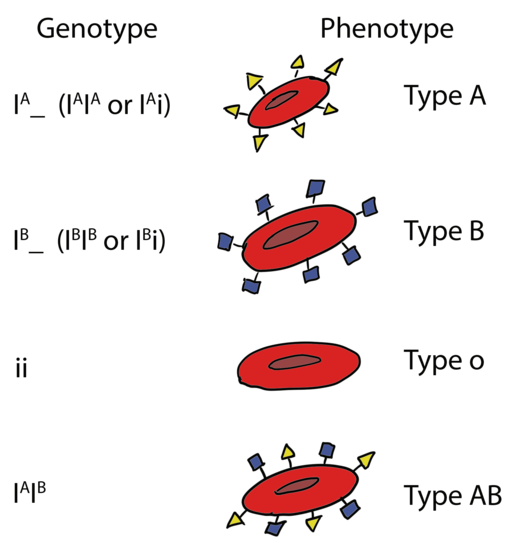Codominance
Codominance is another example of a relationship between alleles that do not show complete dominance or recessiveness. It is often confused with incomplete dominance. However, for incompletely dominant alleles the heterozygote shows an intermediate phenotype. For codominant alleles, the heterozygote shows both alleles.
A classic example of codominance is the ABO blood type locus in humans. Whether an individual has blood type A, AB, B, or O is controlled by a single gene. The gene encodes a proteins (called an antigen) that is embedded in the surface of red blood cells. (A different gene controls whether you have a “positive” or “negative” blood type, eg. AB positive or O negative.) The surface antigens do not affect human health – they have no known function and cells without any of the ABO surface antigen function just fine. However, the antigens become important when a person receives a blood transfusion: some blood types are incompatible with one another, and receiving blood from someone with an incompatible blood type can trigger the recipient’s immune system to attack the foreign cells, resulting in symptoms like fever, pain, red or brown urine, and renal failure.

In the human population, there are three common alleles: IA, IB, and i. IA and IB are codominant to each other. i is recessive to both IA and IB.
Individuals with genotypes IAIA or IAi make type A antigens and have blood type A. Individuals with genotypes IBIB or IBi make type B antigens and have blood type B. Individuals with genotype ii make no surface antigens and have blood type O. Individuals with genotype IAIB make both types of antigens and have blood type AB (Figure 5). Because both protein types are produced – not an intermediate phenotype – the alleles are codominant.
People with AB blood type are said to be universal acceptors for blood transfusions: they can receive blood of any type, since their immune system recognizes both type A antigens and type B antigens as “self”. People with O blood type are universal donors: without any surface antigens, they don’t trigger an immune response in anyone else. People with blood type A cannot receive blood from people with blood type B or AB, and people with blood type B cannot receive blood from people with blood type A or AB.
Test Your Understanding
Media Attributions
- Blood Type Codominance © Wikipedia is licensed under a CC0 (Creative Commons Zero) license

